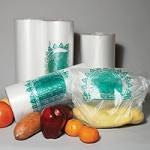 Plastic bags are used for gathering, packaging, carrying and storing stuff. According to SPI, a plastic industry association, about 100,000,000,000 plastic bags are sold annually around the world. Styles abound from no-frills plain plastic bags to upscale bags with patterns, graphics, reinforced bottoms, and fancy handles.
Plastic bags are used for gathering, packaging, carrying and storing stuff. According to SPI, a plastic industry association, about 100,000,000,000 plastic bags are sold annually around the world. Styles abound from no-frills plain plastic bags to upscale bags with patterns, graphics, reinforced bottoms, and fancy handles.
A Few Plastic Bag Types
Plastic bags come in assorted types. For our purposes, we’ll focus on the single-use plastic bags people use for shopping and transporting groceries.
- Grocery Produce / Bulk Bin / Meat Bag — shoppers fill with lettuce, bulk oatmeal, or pork chops at the grocery market.
 T-shirt Bag (so named because it resembles a sleeveless undershirt) — non-sealable sack with handles, also known as grocery or checkout bag.
T-shirt Bag (so named because it resembles a sleeveless undershirt) — non-sealable sack with handles, also known as grocery or checkout bag.- Merchandise Bag — similar to a T-shirt bag with handles die cut into the bag, sometimes handles are reinforced (patch handle).
- High-end Shopping Bag — may have hard or cardboard bottom, upscale handles, colors and graphics, some shoppers view as decorative or status symbol (stores benefit from “walking advertisement”).
Plastic Bag Materials
A variety of materials and manufacturing processes are used to make plastic bags for different uses (produce bag vs. shopping bag). A few materials are listed below:
Polypropylene is a plastic derived from petroleum or natural gas.
 LDPE (low-density polypropylene): offers clarity and flexibility, used to make grocery produce bags, food storage bags, and garbage bags.
LDPE (low-density polypropylene): offers clarity and flexibility, used to make grocery produce bags, food storage bags, and garbage bags.- HDPE (high-density polypropylene): is more rigid and less permeable than LDPE, used for grocery bags and other retail bags.
- LLDPE (linear low-density polypropylene): has higher tensile strength, higher impact, and puncture resistance than LDPE, used for shopping bags.
Bioplastics are made from biomass sources, like vegetable fats and oils and cornstarch, they are often used for vegetable packaging and as organic waste bags.
Plastic Bag History Highlights
Apparently, our love affair with plastic bags began around the mid to late 1950s.
- 1954 – Robert W. Vergobbi patented zipper storage bags
- 1957 – baggies and sandwich bags on a roll are first introduced
- 1965 – Sten Gustaf Thulin’s one-piece “t-shirt” plastic shopping bag design is patented by Celloplast
- 1966 – plastic produce bags on a roll are introduced in grocery markets
- 1974 – department store retailers begin to switch to plastic merchandise bags
- 1977 – plastic grocery bag is introduced as an alternative to paper bags
- 1982 – supermarket chains replace paper bags with plastic bags with handles
- 1990 – on-site plastic bag recycling collection begins at grocery markets
- 1996 – four of five grocery bags used are plastic
- 2011 – over 80% of all bags used are plastic bags
Related Posts
- Bags – Back to Reusable
- Bags – From the Beginning to Paper
- Bags – Paper, Plastic, or Reusable?
- Bags – Paper vs. Plastic: Environmental Impact
- Bags – Paper vs. Plastic: Reuse, Recycle, Compost, or Toss?
- You Can Live Without Single-Use Plastic Bags – Here’s How
Resources
- SPI: The Plastics Industry Trade Association, Inc
- Flexible Film and Bag Division (FFBD) of SPI (link inactive as of December 2012)
- Wikipedia – Plastic Shopping Bag
